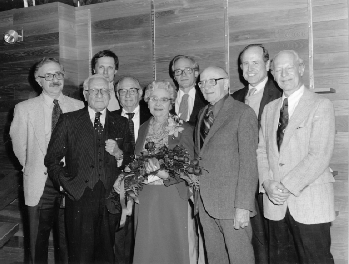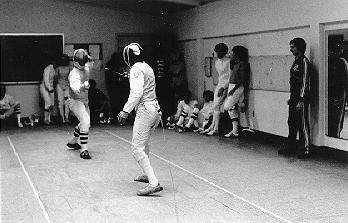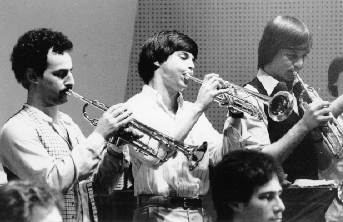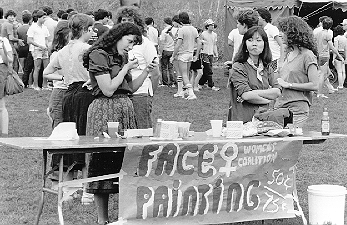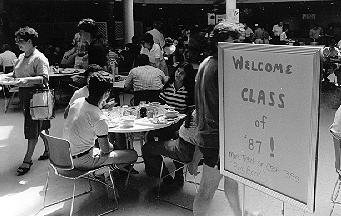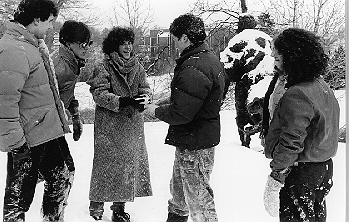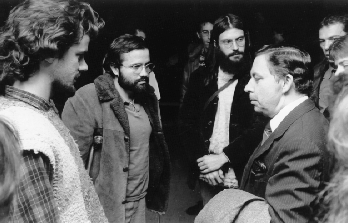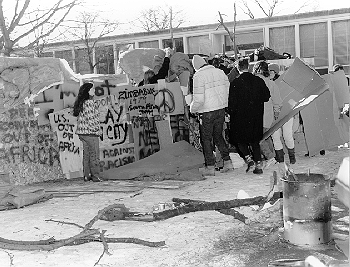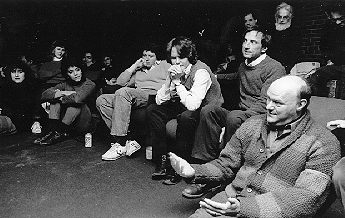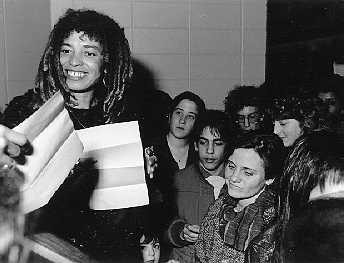The Fourth Decade

Brandeis entered its fourth decade with the uproars of the 60s and early 70s still resonating in the university’s collective memory. The Brandeis undergraduate of the 1980s seemed to some altogether different from the student of the protest era; one cartoon in The Justice declared that the Brandeis student had gone from “96% resistance” in 1970 to “96% compliance” in 1980. The difference, however, may have been more about style than substance. Students during Brandeis’ fourth decade showed the same commitment to social justice characteristic of their predecessors, giving particular attention to women’s issues and to university divestment from corporations doing business in apartheid South Africa.
Faculty commitment to these issues also remained intense; the faculty Advisory Committee for Shareholder Responsibility struggled to assess the moral impact of particular investments in South Africa and to make the case for particular divestitures to the Board of Trustees. By May of 1987, the Board voted to divest South African holdings except for those providing medical or humanitarian services. Students also showed concern over the environmental hazards posed by nuclear power and the plight of Soviet Jews.
In 1983, after 11 years in office, Brandeis University President Marver Bernstein stepped down. The Board of Trustees selected Evelyn Handler, then serving as President of the University of New Hampshire, as his successor. In her inaugural address, President Handler summarized the university’s history, emphasizing the need to build upon existing accomplishments.
“The years ahead will not merely be a replica of the past. If the early years of Brandeis can be likened to the growth and promise of childhood, the exuberance of adolescence, the drive and energy of young adulthood, then the years ahead will bring wisdom, and creativity, and the fulfillment of experience and maturity.”
During President Handler’s administration Brandeis underwent something of an identity crisis. With anti-Jewish enrollment quotas at other schools long since abolished and the number of college-age students dwindling in the mid-80s, the competition for new students was growing increasingly stiff. Hoping to broaden the university’s appeal, President Handler and the Board of Trustees proposed various diversification plans. The most controversial of these called for pork and shellfish to be included in the campus cafeteria menus, a violation of kosher dietary restrictions. Donors were particularly resistant to this proposal, and brought pressure on the administration to abandon it. Although the episode was painful to the university community, its outcome established once and for all that Brandeis, while continuing to welcome any academically qualified student to its campus, would retain with pride its distinctive Jewish identity.
Despite the ongoing budgetary problems that had prompted the re-evaluation and ultimate reaffirmation of its Jewish character, Brandeis continued the important development of its resources, laying the groundwork for expansions of the Goldfarb Library and the athletics facilities, and establishing important new projects like the Tauber Institute for the Study of European Jewry. The University community also had reason to take pride in its intercollegiate athletes, particularly men’s soccer and cross country, each of which brought home regional titles. In 1988 Brandeis was elected to the newly established University Athletic Association.
Visiting dignitaries during the fourth decade included several prominent politicians, for whom Brandeis had come to be an important campaign stop during their 1980 and 1984 campaigns. Brandeis received visits from Sen. John Glenn, Sen. Paul Tsongas, independent presidential candidate John Anderson, Sen. Gary Hart and Governor Michael Dukakis, among others. Other prominent figures appearing on campus included Nazi-hunter Simon Wiesenthal, former U.S. Representative and crusader for women’s rights Bella Abzug, the actors Jessica Tandy and Hume Cronyn, and novelist John Updike, who received the Poses Creative Arts Medal for Fiction and an honorary degree in 1988.
By the close of the fourth decade Brandeis offered 20 degree programs. The Wien Scholars program had sponsored over 700 students from more than 100 lands, and the Hiatt International Center based in Israel had hosted over 600 students from 150 American Colleges and Universities. The completion of the Ziv Quad in the fall of 1987 provided much needed dormitory space for an ever-growing, largely residential undergraduate student body.
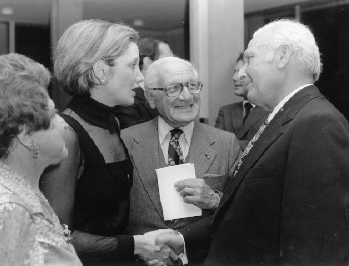
L to R: Thelma Sachar, Elizabeth Rosenstiel Kabler, and Abram Sachar seen here with former President of Israel, Ephraim Katzir. April 5, 1979. On April 5, 1979, Brandeis awarded Dr. Cesar Milstein its eighth annual Rosentiel Award for excellence in scientific research. Milstein was a biochemist at the Medical Research Council Laboratory of Molecular Biology in Cambridge, England who had made critical contributions to the field of immunology with his research of antibodies. The award is named in honor of Lewis S. Rosenstiel who helped create the Rosentiel Basic Medical Sciences Research Center. Dr. Richard Krause, Director of the National Institute of Allergy and Infectious Diseases, delivered the keynote address at the event. Rosentiel director Harlyn Halvorson and Elizabeth Rosenstiel Kalber, a University Fellow, presented the award to Milstein.
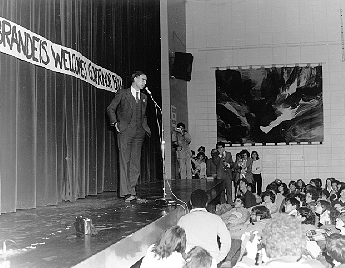
Governor Jerry Brown February 26, 1980. On February 26, 1980, California Governor Edmund G. (Jerry) Brown Jr. gave a campaign speech at Brandeis during his bid to capture the Democratic Party nomination for President. In his speech Brown claimed that President Jimmy Carter did not have a foreign policy plan or a strategy to combat inflation. Brown also touched on defense spending, energy conservation, gun control, the nation's space program, and the United States' support of Israel.
